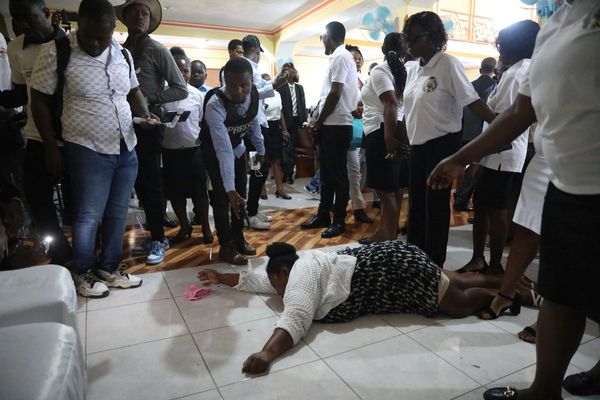
In the beginning was woman. The oldest representation of a human we have – the 40,000-year-old “Venus” of Hohle Fels – is an exaggeratedly fertile woman, the first in a series of Paleolithic statues emphasising breasts, broad hips and the vulva. In the earliest stories, the Earth was female and humanity was created by women, from the Chinese creator goddess Nüwa to the Colombian Kagaba “Mother Creator”. But soon, male creators muscled in. Nüwa became the sister or wife of male creator Fuxi, while in North American stories, an Old Man creator appeared, sitting on the female Earth. “He’s trying to pluck little bits from her, and then he decides to make them alive,” explains Mineke Schipper, gesturing excitedly over Zoom. Schipper is the author of The Shrinking Goddess, a fascinating and enraging account of how the female body has been viewed and treated – essentially, minimised and feared – in myths, legends and spiritual texts from around the world and throughout history.
“When you are comparing more and more of these stories, you see something striking, and that is the independent female creator is gradually becoming the god’s wife,” Schipper says. “Even if God is invisible and no one knows what he looks like, he’s addressed as He, as a father.”
In some places, male figures defiantly created life themselves: in a southeastern Congolese legend, creator god Bumba vomits up humanity; the Egyptian sun god Atum masturbates into his hand, then puts his semen into his mouth, spitting it out as new life. “He insists remarkably much on the fact it’s all his own work,” laughs Schipper.
Schipper has a pantheon of downgraded goddesses, elbowed-out female creators and second-grade Eves at her fingertips. “The first created human being is often a man, then the second one is a woman, and what you’ll notice sometimes is better quality has been used for the first one,” she says. “The wife is created from a small body part of the man. Or God creates the man with the right hand and the woman with the left.” She sees these stories as an attempt by early civilisations to redress what they saw as the essential unfairness that only women had the power to give life. “It has to do with the lack of balance with what women can do – it’s already too much.”
Women as “too much”, who need to be shut down, is a narrative Schipper, now 85, has been challenging since childhood. She grew up in the Netherlands with five brothers – something she sees as having influenced her as she interrogated gender difference and similarity, and how the sexes are perceived and expected to behave. She says she clashed early and often with her conventional mother. “Her message to me was that there are two paths: the path of men and the path of women. The path of women is less interesting, but you have to walk on it. I asked her, ‘Why do you care what people are saying?’” Schipper decided not to care, she says, when she turned 11, refusing to wear a skirt for dinner. “This started early.”
Schipper first became interested in oral tradition living in the Republic of the Congo. She and her husband, a historian, moved there to work as university lecturers in 1964. It was a bloody, turbulent time, when the early dream of independence had been catastrophically soured by the murder of prime minister Patrice Lumumba; there was active fighting and hostage-taking. She tells the story of their four years with laconic understatement: “Sometimes there was no bread; sometimes there was no water… and for one year we weren’t paid by the Congolese government and we had to borrow money. But things are so relative.” Her family was less stoic: “My parents were weeping in the airport, because they said, ‘We’ll never see this daughter back.’”
It was a formative experience in many ways. “You’re young, you have no experience, so you learn in a few months,” she says. Immersed in a new culture, she developed an interest in proverbs. “I think it was [novelist] Chinua Achebe who once said, ‘Proverbs are the palm oil with which words are eaten.’ It’s true. People love proverbs everywhere.” She started scribbling down those she heard around her, encouraging her students to ask their grandparents for more. They compiled their research into “a rather chaotically organised radio programme”.
Schipper had her first child while in the Congo, which opened another vista of traditional wisdom. She and her husband, she said, were surprised when their neighbours came to thank them after the baby was born: “It means you have contributed new energy, new power to the community by having a baby. I found this very beautiful.”
Her experiences and research crystallised into a powerful intellectual curiosity about how female traits have been perceived around the world. You can’t live in a female body and not notice the myriad ways it’s exalted, objectified, feared and reviled. There’s our weird discomfort around pregnancy and breastfeeding, our fetishisation of “curves” and preoccupation with weight; the ways, mostly male, legislators seek to restrict reproductive rights, down to tracking our menstrual cycles. From FGM to wikiFeet, women’s bodies are everyone’s business.
What’s less obvious is how ancient and cross-cultural many of those attitudes are and how they developed. Part of the reason why we’re not aware of this is that historically it has been a dramatically understudied area. As Schipper says, anthropologists used to be men; they neither investigated nor had access to female spaces, traditions and oral cultures. Back in the Netherlands with two young children and an academic career in comparative literature, Schipper chipped away at this, continuing to collect proverbs on women for over a decade. “Whenever I was sitting in an aeroplane or a taxi – wherever you are, you can always have a conversation and people love it. Particularly when it is about men and women, you can have a lot of fun.” That culminated in a book, and the Women in Proverbs Worldwide website with more than 15,000 proverbs.
Common themes that intrigued her emerged from that work: the metaphors used for, and around women; the way value and virtue are ascribed to women and especially the powerful charge that parts of the female body exert. “The thing you share all over the world is, of course, your body,” she says. Gradually, The Shrinking Goddess crystallised. It’s scholarly but compulsively readable, packed with jaw-dropping detail. I found myself telling stories from Schipper’s strange treasury for weeks after I read it. From the hymen to the vulva, menstruation to childbearing, the myths she has collected coalesce into an overarching story of fear, envy and appropriation of female biology.
On breasts alone, Schipper ranges across the “god who suckles” (El Shaddai) in early Judaism; 12th-century paintings of Christ with a heaving womanly bosom; the Indian god Prajapati giving himself breasts so his creations “could suckle and live”; how depictions of Mary gradually covered up her breasts over time, and the soft power of wet nurses.
“Isn’t it amazing how the image of the breast has changed?” Schipper marvels. They have become less about function, more about desire, leaving us uncomfortable with breastfeeding, she says: “How dare you show your breast… you go against the erotic image of the breast.” A section on “milk ties” in the book is really fascinating: cultures as disparate as the Balkans, Palestine and North Africa had traditions based on the belief that breastfeeding an adult can create a “safe”, non-sexual quasi-family bond with them. In Georgia, for instance, a man who thought his wife was unfaithful could make her suspected lover kiss her breast. Once he had done so, the husband “could now rest assured: his wife and new milk son-in-law could meet openly”. A widely condemned fatwa from a Cairo-based Islamic scholar in 2007 even suggested that women could breastfeed male colleagues to prevent undesirable workplace interactions between the sexes: “After five feeds, ‘milk ties’ are established, preventing any sexual relations.”
Another revealing section tackles myths around the vagina and vulva. Schipper’s grandmother, she explains in the book, referred to the vulva as the “mystery”, which seems appropriate given the fear and awe with which it has been viewed. Through amulets and talismans or rituals such as a priestess exposing her genitals in one ancient Chinese tradition, the vulva could offer protection or salvation from rainless skies, infertile fields or enemies. “It was protection, because it was the gate of life,” Schipper explains, but “we seem to have forgotten.”
Replacing it came the notion of the vagina as a source of terror and danger, which is similarly strong. A Māori tradition warns against the vagina as the “house of death” and pervasive vagina-with-teeth (vagina dentata) myths across the world conjure genitals booby-trapped with snakes, a saw, elephant tusks and more. For Schipper, it’s a sublimation of performance anxiety: “There are so many stories. Imagine you have to have sex for the first time and you think there are piranhas inside? Horrible anxieties.”
Things have improved – Schipper herself has lived through an era of dramatic progress towards gender parity and her own relationship seems to have been a true partnership of equals (her husband, she says, so hated the idea of hierarchical relationships that “he was very hesitant to marry at all”). “We have a new situation in which women do all the things their grandmothers and even their mothers were not able to do,” she says. No one is suggesting women who study will shrink their ovaries for a start (though she notes the argument was raised in Saudi Arabia in the not-too-distant past as a reason for women not to drive). It’s a time, too, of asking searching questions of received notions of sex and gender. Schipper discusses how science could help all genders “share all birth-giving, breastfeeding and other care duties”, and says she looks forward to reading about the experiences of trans individuals and “how their experience of body parts resonates and differs from the experiences of cis- gendered individuals”.
Too much, though, has not changed since early myths started to erase women and encourage us to fear them. Violence remains, everywhere. It’s debatable, too, how comfortable women are with their own bodies – it’s hard to love what the world despises and distrusts. Schipper notes the trend for cosmetic vulva surgery, women wanting “to adapt their vulva to some criteria from somewhere” (porn, I suspect). But that discomfort, she says, applies to men as well as women. “Growing up with five brothers helps you see that everybody is insecure.”
Schipper keeps her own body healthy with an hour’s walk in the Amsterdam woods each morning and by doing yoga; her mind is clearly still as sharp as ever. She has just completed a book on widowhood, an intellectual exploration of her own grieving process. “I became a widow in 2020, my comrade of life died, so I decided to find out what is a widow around the world.” She’s already deep into the next: a study of the soul. “Nobody has ever seen a soul – what does it look like? I’m trying to find soul images. Where does the soul sit in the body? Why did death come to the world? It’s fascinating.”
On the still-taboo topic of female biology, Schipper tells me how, at a talk she gave in Alexandria, Egypt, a woman in the audience asked her how she talked about sex, masturbation and genitals without embarrassment. “I said, you know, half of humanity has these body parts, there is nothing unusual or uncommon. The more we talk about it, the less stress we will develop mutually. Instead of despising each other, I think you can develop new, different relations.”
There’s so much more that unites than divides different cultures and the sexes, she believes. “The basic question I have always asked is: what do we share?”
The Shrinking Goddess: Power, Myth and the Female Body by Mineke Schipper has just been published by the Westbourne Press at £16.99







